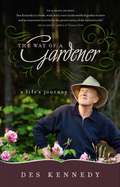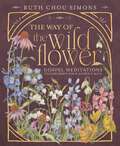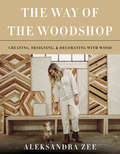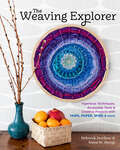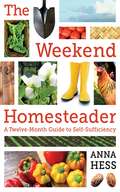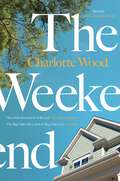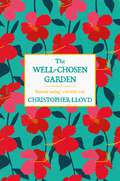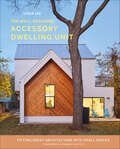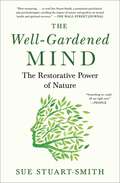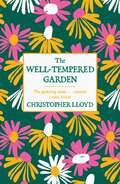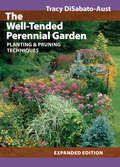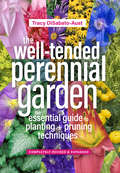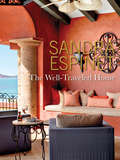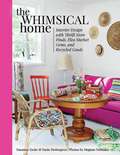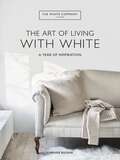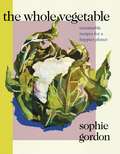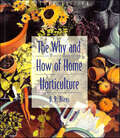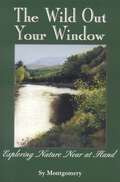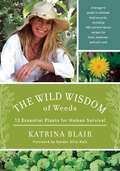- Table View
- List View
The Way of a Gardener
by Des KennedyAccomplished novelist, satirist, and garden writer Des Kennedy describes his life journey from a childhood of strict Irish Catholicism in England to a charmed existence amid the gardens of his Gulf Island home in British Columbia. From his First Holy Communion to his days as a young seminarian, through the Beat poetry scene in New York and the social upheavals of the 1960s, this monk-turned-pilgrim pursues a quest for meaning and purpose. After leaving monastic life and moving west, Kennedy takes up a new vocation in what has been called the Church of the Earth. On a rural acreage, he and his partner build their home from recycled and hand-hewn materials and create gardens that provide food as well as a symbiosis with the Earth that is as profoundly spiritual as past religious rituals. Spiced with irreverence and an eye for the absurd, The Way of a Gardener ranges over environmental activism, aboriginal rights, writing for a living, amateur wood butchery, the protocols of small community living, and the devilish obscenity of a billy goat at stud.
The Way of the Wildflower: Gospel Meditations to Unburden Your Anxious Soul
by Ruth Chou SimonsDiscover how to live freely and release your burdens with gospel meditations that turn your focus to the God who cares deeply for you.Are you looking for a new way of living? A way to stop anxious thoughts and release heavy burdens you aren't meant to carry?In The Way of the Wildflower, bestselling author and artist Ruth Chou Simons invites you to draw inspiration for your weary soul from the flowers of the field through thirty gospel focused meditations covering five ways of the wildflower: Dependency, Freedom, Resilience, Unhurriedness, and Belovedness.This gorgeous, full-color devotional features Ruth's signature art and stunning hand-painted botanicals, alongside:Bible verses to meditate onPractical applications of God's WordKey truths to preach to yourself when you feel burdenedPrayers to help you practice the way of the wildflowerWildflower facts and the lessons we can learn from them If you're wrestling with your past, struggling in your present, or fearful for your future, pause and be still. Consider how the wildflowers grow, remember that the God who cares for them cares for you, too, and let your anxious soul find rest in Him. &“Who of you by worrying can add a single hour to your life? Since you cannot do this very little thing, why do you worry about the rest? Consider how the wild flowers grow. They do not labor or spin. Yet I tell you, not even Solomon in all his splendor was dressed like one of these. If that is how God clothes the grass of the field, which is here today, and tomorrow is thrown into the fire, how much more will he clothe you—you of little faith!&” — Luke 12:25–28 (NIV)
The Way of the Woodshop: Creating, Designing & Decorating with Wood
by Aleksandra ZeeShop Class as Soulcraft meets Norwegian Wood in this gorgeously illustrated DIY guide for aspiring woodworkers of all levels.“There’s just something about wood. It’s an imperfect material with cracks, knots, and irregularities. As an imperfect being, I find that by working with wood and all its inconsistencies, I can also tackle my own.” –Aleksandra ZeeRoll up your sleeves and get ready to master the basics of woodworking in Aleksandra Zee’s cozy Bay Area studio. The Way of the Woodshop is a meditative guidebook and a feast for the eyes, an illustrated journey through the joys of working, decorating, and crafting with wood. Packed with gorgeous photography and do-it-yourself projects ranging from easy to advanced, The Way of the Woodshop takes you step by step through the process of creating nesting cutting boards, a blanket ladder, a daybed, a table and bench, and more. Zee covers the basics, from choosing the right lumber, to understanding different wood types and grains, to curating a tool collection, along with tips on decorating with wood and curating a space that you love. Along the way, she encourages you to tap into your creativity and relish the joys of working with your hands, and she shares lessons from her own empowering journey, as a woman carving out her space in a stereotypically male profession.Whether you want to decorate your home, create personal gifts, or just love handmade objects, The Way of the Woodshop will inspire you to grab a sander and discover the joy of making!
The Weaving Explorer: Ingenious Techniques, Accessible Tools & Creative Projects with Yarn, Paper, Wire & More
by Gwen W. Steege Deborah JarchowWeaving is a highly accessible craft — over, under is the basic technique — but the stumbling block for many would-be weavers has been the high cost of a commercial loom. The Weaving Explorer removes that barrier, inviting crafters and artists to try out an amazing range of techniques and creative projects that are achievable with a simple homemade loom, or no loom at all! Weavers Deborah Jarchow and Gwen W. Steege take inspiration from the world of folk weaving traditions, adding a contemporary spin by introducing an unexpected range of materials and home dec projects. From sturdy rag fabric grocery bags to freeform wire baskets, delicately woven thread bracelets to colorful woven rugs, crafters will delight in exploring the opportunities to make their own personal variations on these beautiful — and functional — creations. This publication conforms to the EPUB Accessibility specification at WCAG 2.0 Level AA.
The Weekend Homesteader: A Twelve-Month Guide to Self-Sufficiency
by Anna HessThe Weekend Homesteader is organized by month--so whether it's January or June you'll find exciting, short projects that you can use to dip your toes into the vast ocean of homesteading without getting overwhelmed. If you need to fit homesteading into a few hours each weekend and would like to have fun while doing it, these projects will be right up your alley, whether you live on a forty-acre farm, a postage-stamp lawn in suburbia, or a high rise. You'll learn about backyard chicken care, how to choose the best mushroom and berry species, and why and how to plant a no-till garden that heals the soil while providing nutritious food. Permaculture techniques will turn your homestead into a vibrant ecosystem and attract native pollinators while converting our society's waste into high-quality compost and mulch. Meanwhile, enjoy the fruits of your labor right away as you learn the basics of cooking and eating seasonally, then preserve homegrown produce for later by drying, canning, freezing, or simply filling your kitchen cabinets with storage vegetables. As you become more self-sufficient, you'll save seeds, prepare for power outages, and tear yourself away from a full-time job, while building a supportive and like-minded community. You won't be completely eliminating your reliance on the grocery store, but you will be plucking low-hanging (and delicious!) fruits out of your own garden by the time all forty-eight projects are complete.
The Weekend: An unforgettable story of female friendship by the bestselling author of the Booker Prize-shortlisted Stone Yard Devotional
by Charlotte Wood'So great I am struggling to find the words to do it justice' Marian KeyesA Book of the Year for The Times, Observer, Independent and Good Housekeeping'A rare pleasure' Sunday Times'Riveting' Elizabeth Day'A perfect, funny, insightful, novel about women, friendship, and ageing' Nina Stibbe'A lovely, lively, intelligent, funny book' Tessa Hadley'Glorious . . . Charlotte Wood joins the ranks of writers such as Nora Ephron, Penelope Lively and Elizabeth Strout' GuardianSylvie, Jude, Wendy and Adele have been friends for decades, but when Sylvie dies, the ground shifts dangerously for the remaining three.These women couldn't be more different: Jude, a once-famous restaurateur with a long-standing affair with a married man; Wendy, an acclaimed feminist intellectual; Adele, a former star of the stage, now practically homeless. Struggling to recall exactly why they've remained close all these years, the grieving women gather for one last weekend at Sylvie's old beach house. But fraying tempers, an elderly dog, unwelcome guests and too much wine collide in a storm that threatens to sweep away their friendship for good.
The Well-Chosen Garden
by Christopher LloydThe perfect book on how to make your garden the best it can be.'Essential reading' Country Life'Funny, encouraging, informative' Sunday TimesWould your garden, small or large, in town or country, win a prize? Is there room for improvement? Everybody has favourite plants, but the ability to put them all together to ensure a splendid show throughout the year is a skill that must be acquired. THE WELL-CHOSEN GARDEN will guide you to making the most of your available space, help you avoid untimely gaps, colour clashes and many other pitfalls of garden planning.The perfect book for new and experienced gardeners alike.
The Well-Chosen Garden
by Christopher LloydThe perfect book on how to make your garden the best it can be.'Essential reading' Country Life'Funny, encouraging, informative' Sunday TimesWould your garden, small or large, in town or country, win a prize? Is there room for improvement? Everybody has favourite plants, but the ability to put them all together to ensure a splendid show throughout the year is a skill that must be acquired. THE WELL-CHOSEN GARDEN will guide you to making the most of your available space, help you avoid untimely gaps, colour clashes and many other pitfalls of garden planning.The perfect book for new and experienced gardeners alike.
The Well-Designed Accessory Dwelling Unit: Fitting Great Architecture into Small Spaces
by Lydia LeeAn inspirational look book for conceiving, planning, and building an accessory dwelling unit (ADU), a small house that is on the same property as the main house—a quickly growing trend that is transforming our vision of what a dream home should be. ADUs offer homeowners opportunities to host family and friends, add studio or office space, or generate passive income through a long-term rental on their existing property. Combine these practical benefits with broad and preferential rezoning in many municipalities throughout the US, and ADUs are one of the biggest developments in housing. Written by award-winning architecture and design writer Lydia Lee, this thoughtful exploration of ADUs answers many of the questions that arise when thinking about investing in an ADU. From design strategies and challenges to understanding zoning regulations to financing and material selection, this title covers the need-to-know basics on ADUs in addition to presenting expert advice from architects, builders, and homeowners. Accompanying this information are extensive looks at 15 carefully designed ADUs from the US and Canada, complete with showstopping photos, floor plans, and informative text boxes. Readers will learn unique perspectives from each project including green building solutions, practical architectural solutions to optimize limited space, and the pitfalls homeowners encountered and resolved. Content includes • insights shared by architects and ADU owners from 15 projects in the US and Canada; • floor plans and high-end interior and exterior project photography; • discussion of prefabricated materials, green building, and storage solutions; and • a primer on zoning, financing, building, and more. With so many possibilities and opportunities for ADUs, this book is ideal for homeowners, architects, interior designers, builders, and developers.
The Well-Gardened Mind: The Restorative Power of Nature
by Sue Stuart-SmithA distinguished psychiatrist and avid gardener offers an inspiring and consoling work about the healing effects of gardening and its ability to decrease stress and foster mental well-being in our everyday lives.The garden is often seen as a refuge, a place to forget worldly cares, removed from the &“real&” life that lies outside. But when we get our hands in the earth we connect with the cycle of life in nature through which destruction and decay are followed by regrowth and renewal. Gardening is one of the quintessential nurturing activities and yet we understand so little about it. The Well-Gardened Mind provides a new perspective on the power of gardening to change people&’s lives. Here, Sue Stuart-Smith investigates the many ways in which mind and garden can interact and explores how the process of tending a plot can be a way of sustaining an innermost self. Stuart-Smith&’s own love of gardening developed as she studied to become a psychoanalytic psychotherapist. From her grandfather&’s return from World War I to Freud&’s obsession with flowers to case histories with her own patients to progressive gardening programs in such places as Rikers Island prison in New York City, Stuart-Smith weaves thoughtful yet powerful examples to argue that gardening is much more important to our cognition than we think. Recent research is showing how green nature has direct antidepressant effects on humans. Essential and pragmatic, The Well-Gardened Mind is a book for gardeners and the perfect read for people seeking healthier mental lives.
The Well-Tempered Garden: A New Edition Of The Gardening Classic
by Christopher LloydA timeless gardening classic by Christopher Lloyd, one of Britain's most highly respected plantsmen, updated for the 21st century. With a new foreword by Anna Pavord.This is a classic work by a gardener who combines a passionate love of his subject with a critical intelligence and a good helping of wit. THE WELL-TEMPERED GARDEN is packed with the sort of information keen gardeners crave - from planting, weeding and the pleasures of propagation to annuals, water lilies and vegetables. Hailed as a masterpiece when it was first published, THE WELL-TEMPERED GARDEN is as fresh, enlightening and necessary for gardeners in the 21st century as it was when it first appeared more than 40 years ago.
The Well-Tended Perennial Garden: Planting & Pruning Techniques
by Tracy DiSabato-AustWith more than 180,000 copies sold since its original publication, The Well-Tended Perennial Garden has proven itself to be one of the most useful tools a gardener can have. Now, in this expanded edition, there's even more to learn from and enjoy. This is the first, and still the most thorough, book to detail essential practices of perennial care such as deadheading, pinching, cutting back, thinning, disbudding, and deadleafing, all of which are thoroughly explained and illustrated. More than 200 new color photographs have been added to this revised edition, showing perennials in various border situations and providing images for each of the entries in the A-to-Z encyclopedia of important perennial species. In addition, there is a new 32-page journal section, in which you can enter details, notes, and observations about the requirements and performance of perennials in your own garden. Thousands of readers have commented that The Well-Tended Perennial Garden is one of the most useful and frequently consulted books in their gardening libraries. This new, expanded edition promises to be an even more effective ally in your quest to create a beautiful, healthy, well-maintained perennial garden.
The Well-Tended Perennial Garden: The Essential Guide to Planting and Pruning Techniques, Third Edition
by Tracy DiSabato-Aust“This practical guide is lush with clear, step-by-step advice.” —Real Simple Since its original publication twenty years ago, The Well-Tended Perennial Garden has helped home gardeners successfully plan, plant, and tend their gardens. Now Tracy Di-Sabato-Aust’s trusty advice and reassuring tone are back and better than ever in this completely revised new edition. Novice and experienced gardeners alike will benefit from Tracy’s thorough details on the essential practices of perennial care—included deadheading, pinching, and thinning—along with growing information for new species and cultivars, on-trend garden design advice, a monthly planting and maintenance schedule, and details on native plants and gardening for wildlife. The Well-Tended Perennial Garden is a must-have ally in the quest for a beautiful, well-maintained garden.
The Well-Traveled Home
by Sandra EspinetLuxury homes with international panache—includes over 175 exquisite photos.Sandra Espinet&’s extensive world travels produce finds of exquisitely wrought artisanal furniture, dramatic artworks, and exotic accessories that are put to beautiful use in interiors. Blending the fabulous objects culled from particular corners of the globe is a delicate art form. Well-known to viewers of HGTV, Espinet is a mix-master of eclectic convergence, a specialist in the fearless melding of exotic elements with traditional furnishings into stylish and unforgettable presentations of comfort and calm, exhilaration and extravagance. This gorgeous book showcases her unique knack for incorporating international treasures into alluring domestic living spaces.
The Wellness Mama 5-Step Lifestyle Detox: The Essential DIY Guide to a Healthier, Cleaner, All-Natural Life
by Katie WellsKatie Wells, author of The Wellness Mama Cookbook and founder of wellnessmama.com, finally shares the secret of how she manages six kids, a company, and a career without sacrificing a healthy lifestyle with this step-by-step, comprehensive guide to clean, natural living.By following her simple detox plan, you'll be able to implement a system for better living by reducing toxic exposure, transforming your diet, and regaining control over your health. Katie provides practical tips for slowly incorporating this rewarding lifestyle into an already busy schedule, giving you the option to choose what area of life you'd like to work on first. You can detox your body with whole foods and natural medicines; clean up your beauty regime with all-natural moisturizers, cleansers, hair products, and makeup; get rid of toxic household products that include bleach, ammonia, and acids; try a digital detox for you and your family; or learn how to de-stress by adopting healthier sleeping habits and finding time for yourself. The Wellness Mama 5-Step Lifestyle Detox is the natural answer to matters of home, nutrition, and motherhood with over 150 homemade versions of essential household and personal products like: -Citrus Fresh All-Purpose Cleaner-Unscented Liquid Laundry Detergent-Lavender and Honey Face Wash- Mineral Foundation-Lemon Cinnamon Cough Syrup-Chamomile Calming Balm
The Whimsical Home: Interior Design with Thrift Store Finds, Flea Market Gems, and Recycled Goods
by Sania Hedengren Susanna ZackeVintage clothing, vintage décor--it simply never gets old and continues to be one of the hottest style trends! Now, you too can create a beautiful vintage home environment that is sure to be the envy all your peers. In The Whimsical Home, master crafters Sania and Susanna show us five different homes furnished with different vintage pieces. Each chapter ends with tips to achieve these fun and whimsical looks. And the best part? None of these exquisite looks will cost you an arm and a leg. Chances are you probably already have a lot of key pieces just lying around your home. Sania and Susanna will show you exactly how to use them. Crafts include: Concrete candle holders A stool decorated with domino pieces A picture made of potholders Follow Sania and Susanna as they travel from home to home, casting in concrete, crocheting, sewing, building, painting, and revamping. Learn how to mix and match unique flea-market finds with modern furniture, and how to reuse old trinkets you may have lying around your house. Be inspired by Sania and Susanna’s expertise and advice. Let your imagination run wild; the sky is the limit. Your house will be beautiful, unique, and the envy of homeowners everywhere.
The White Company The Art of Living with White: A Year of Inspiration (White Company)
by Chrissie Rucker Company'I love a home to feel warm, inviting, personal and lived-in - and mastering how to decorate with white and neutrals is a wonderful way to achieve this.''- CHRISSIE RUCKERIn her much-anticipated second book, The Art Of Living With White, Chrissie Rucker, Founder of The White Company, explores 10 inspirational homes that illustrate beautifully different ways to use white and neutrals through the seasons. The homes vary in size, style and location - from a minimalist city pied-à-terre to a New England-style country house - but what unites them all is the welcoming, stylish and calm feel that their owners have each created.The homes are grouped into the four seasons and each chapter ends with a summary of seasonal rituals that will work in any home. A concluding chapter - Inspiration & Resources - considers finding your own style, how to create a good balance between work and home in interior spaces, the art of simple entertaining and the importance of scent and touch in a truly comfortable home.
The White Company The Art of Living with White: A Year of Inspiration (White Company)
by Chrissie Rucker CompanyFrom the author of the home decorating bestseller, For the Love of White, comes an inspirational and informative guide to creating a welcoming home through the seasons using a white and neutral palette.'I love a home to feel warm, inviting, personal and lived-in - and mastering how to decorate with white and neutrals is a wonderful way to achieve this.' - CHRISSIE RUCKERIn her much-anticipated second book, The Art Of Living With White, Chrissie Rucker, Founder of The White Company, explores 10 inspirational homes that illustrate beautifully different ways to use white and neutrals through the seasons. The homes vary in size, style and location - from a minimalist city pied-à-terre to a New England-style country house - but what unites them all is the welcoming, stylish and calm feel that their owners have each created.The homes are grouped into the four seasons and each chapter ends with a summary of seasonal rituals that will work in any home. A concluding chapter - Inspiration & Resources - considers finding your own style, how to create a good balance between work and home in interior spaces, the art of simple entertaining and the importance of scent and touch in a truly comfortable home.Praise for The White Company: For the Love of White'A testament to the power of neutrals' - House and Garden'A visual feast with a passion for all things white at its heart' - House Beautiful
The Whole Vegetable: Sustainable and delicious vegan recipes
by Sophie GordonDiscover wholesome, sustainable and plant-based dishes in this essential cookbook, perfect for anyone looking to reduce their waste this year!'Hearty, healthy, flavour-packed dishes' MAIL ON SUNDAY'A uniquely sustainable and delicious approach to modern plant-based cooking' VOGUE'The Whole Vegetable blew me away . . . Full of inventive waste-free recipes' Tom Hunt, GUARDIAN_________Have you ever wondered how to make your diet truly eco-conscious?In this beautiful plant-based cookbook, over 130 creative, delicious, planet-friendly recipes put vegetables at the very centre of the table. Embracing often-discarded parts such as leaves, stalks, tops, flowers, seeds and even peelings, this is cooking at its most sustainable.In The Whole Vegetable, Sophie Gordon shows us how to:- Cook with every part of every vegetable- Reduce waste in your cooking- Reinvent your leftovers- Eat with the seasonsFrom Cauliflower Carbonara, Broccoli Pesto and Chunky Pumpkin Tacos, to Cherry Breakfast Crumble, Maple-Roasted Pears and Apple & Walnut Danish Buns, The Whole Vegetable is packed with thoughtful recipes for every season.Most of all, it will ensure that nothing in your kitchen goes to waste._________'Creative, delicious, planet-friendly recipes . . . Teaches you how to put those often discarded parts of fruit and veg to good (and tasty) use' Women's Health'Wow, Sophie Gordon's . . . The Whole Vegetable blew me away. I wonder if she is the next Anna Jones. A seasonal, plant-centric, whole food recipe book without ultra-processed vegan ingredients. The recipes are super-inventive and importantly waste free!' Eco-Chef Tom Hunt'The Whole Vegetable heroes plant-based cookery, with recipes that also help reduce food waste in the kitchen and improve sustainable living. A worthwhile read' Good Housekeeping
The Why and How of Home Horticulture
by D. R. BienzWhether you are a beginning or experienced gardening enthusiasts, a student of gradening, or a horticultural professional, The Why and How of Home Horticulture, Second Edition will prepare you to face virtually any gardening situation. Like no other gardening book, it supports its practical, how-to-do-it guidelines with clear explanations of the relevant scientific principles of horticulture. You will know what steps to take--and why those steps are working.The Why and How of Home Horticulture ranges from the aesthetics and history of gardening to essential techniques and practices for indoor or outdoor ornamental gardens, vegetable gardens, and home orchards. Thoroughly updated, this new edition includes information and issues that have emerged in the last decade, particularly in the areas of organic gardening, biotechnology, and genetic engineering. And as before, the final chapter is a complete, self-contained gardening handbook offering practical tips for everything from soil preparation to processing the harvest.The Why and How of Home Horticulture, Second Edition--no other horticulture guidebook so clearly articulates the science, the skills, and the pleasures of gardening.
The Wild Garden: Expanded Edition
by William Robinson Rick DarkeFirst published in 1870, The Wild Garden challenged the prevailing garden style of the day and advocated a naturalistic style, in which hardy plants, both native and exotic, are arranged in groupings that mimic wild landscapes. Thanks to Robinson’s passionate advocacy, the naturalistic style triumphed, and Robinson's urgent message continues to resonate today. For this newly designed edition, Rick Darke has written an introductory essay that not only underscores Robinson’s importance in the evolution of garden design and ecology, but also explains his relevance for today’s gardeners, designers, and landscape professionals. The book contains over 100 stunning photographs taken by Darke, including images of Gravetye and of modern “wild” gardens.
The Wild Out Your Window
by Sy MontgomeryWhat could be better than watching the natural world out your window or on your television? Going out and experiencing it firsthand. In these fifty essays, acclaimed nature and science writer Sy Montgomery takes her readers on a season-by-season tour of the wilderness that is often as close as the backyard. Sy invites — almost dares — readers to follow her and form hands-on relationships with the plants, animals, birds, and even the insects that share space with people. These essays, most of which originally appeared in Sy's Boston Globe column Nature Journal, are by turns enlightening, entertaining, sometimes amusing, and always absorbing and informative. Filled with natural history and lore, the essays urge readers to appreciate what they find around them.
The Wild Wisdom of Weeds: 13 Essential Plants for Human Survival
by Katrina BlairThe Wild Wisdom of Weeds is the only book on foraging and edible weeds to focus on the thirteen weeds found all over the world, each of which represents a complete food source and extensive medical pharmacy and first-aid kit. More than just a field guide to wild edibles, it is a global plan for human survival. When Katrina Blair was eleven she had a life-changing experience where wild plants spoke to her, beckoning her to become a champion of their cause. Since then she has spent months on end taking walkabouts in the wild, eating nothing but what she forages, and has become a wild-foods advocate, community activist, gardener, and chef, teaching and presenting internationally about foraging and the healthful lifestyle it promotes. Katrina Blair&’s philosophy in The Wild Wisdom of Weeds is sobering, realistic, and ultimately optimistic. If we can open our eyes to see the wisdom found in these weeds right under our noses, instead of trying to eradicate an &“invasive,&” we will achieve true food security. The Wild Wisdom of Weeds is about healing ourselves both in body and in spirit, in an age where technology, commodity agriculture, and processed foods dictate the terms of our intelligence. But if we can become familiar with these thirteen edible survival weeds found all over the world, we will never go hungry, and we will become closer to our own wild human instincts—all the while enjoying the freshest, wildest, and most nutritious food there is. For free!The thirteen plants found growing in every region across the world are: dandelion, mallow, purslane, plantain, thistle, amaranth, dock, mustard, grass, chickweed, clover, lambsquarter, and knotweed. These special plants contribute to the regeneration of the earth while supporting the survival of our human species; they grow everywhere where human civilization exists, from the hottest deserts to the Arctic Circle, following the path of human disturbance. Indeed, the more humans disturb the earth and put our food supply at risk, the more these thirteen plants proliferate. It&’s a survival plan for the ages.Including over one hundred unique recipes, Katrina Blair&’s book teaches us how to prepare these wild plants from root to seed in soups, salads, slaws, crackers, pestos, seed breads, and seed butters; cereals, green powders, sauerkrauts, smoothies, and milks; first-aid concoctions such as tinctures, teas, salves, and soothers; self-care/beauty products including shampoo, mouthwash, toothpaste (and brush), face masks; and a lot more. Whether readers are based at home or traveling, this book aims to empower individuals to maintain a state of optimal health with minimal cost and effort."Katrina Blair&’s charming and intelligent The Wild Wisdom of Weeds … delivers just about the best argument I&’ve read for the futility of figuring out what, exactly, qualifies as a native plant and why &‘invasive&’ can be a flawed concept."—New York Times&“The Wild Wisdom of Weeds is one of those rare and important books that has the capacity to radically alter your view of a world you thought you knew well. You'll never look at weeds the same again!&”--Ben Hewitt, author of The Nourishing Homestead
The Wildlife Garden
by John Lewis-StempelWith the erosion of native wildlife habitats, gardens increasingly provide an invaluable source of food and shelter for Britain's fauna and flora. The Wildlife Garden is the essential guide to attracting birds to your bushes, butterflies to your buddleia and a whole array of other creatures into your garden - even if you only have a window box. Whether you just want to make an existing family space more wildlife friendly or go the whole hedgehog and turn your back garden into a mini nature reserve The Wildlife Garden will show you how to do it. There is full information on what plants are best for wildlife, on how to make refuges for insects and homes for bats, on making a pool for frogs, all whilst adding scent and colour to your surroundings.
The Wildlife Garden
by John Lewis-StempelWith the erosion of native wildlife habitats, gardens increasingly provide an invaluable source of food and shelter for Britain's fauna and flora. The Wildlife Garden is the essential guide to attracting birds to your bushes, butterflies to your buddleia and a whole array of other creatures into your garden - even if you only have a window box. Whether you just want to make an existing family space more wildlife friendly or go the whole hedgehog and turn your back garden into a mini nature reserve The Wildlife Garden will show you how to do it. There is full information on what plants are best for wildlife, on how to make refuges for insects and homes for bats, on making a pool for frogs, all whilst adding scent and colour to your surroundings.
